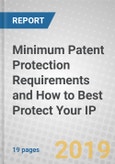The Report Includes:
- An overview of copyrights, patents and trademarks
- Knowledge about the global distribution of patents, IP filings and economic growth
- Coverage of facts about the licensing world and description of major license formats
There have always been copycats. Intellectual property (IP) protection and better regulations are now helping inventors and creators work more confidently. Increasing openness in the broader environment is also working towards moving from monopolies to “manypolies.”
Boris Johnson, the British prime minister, explains it colorfully: “You know, sometimes I don't understand what's wrong with us. This is just about the most creative and imaginative country on Earth - and yet sometimes we just do not seem to have the gumption to exploit our intellectual property. We split the atom, and now we have to get French or Korean scientists to help us build nuclear power stations. We perfected the finest cars on earth - and now Rolls-Royce is in the hands of the Germans. Whatever we invent, from the jet engine to the internet, we find that someone else carts it off and makes a killing from it elsewhere.”
Having an original great new idea is only part of your innovation story. There also needs to be a thriving ecosystem to further support and extend the value and monetization of those original ideas. So while the patent is of paramount importance, there must also be more that is put into place to draw support from, to help the innovation get to the market. Here is where the tech transfer “hand-off” and venture communities must help bridge the gulf between inspiration and implementation. Judging just how much to put into the former versus the latter is a fine line at times. Russia historically has been home to many of the scientific revelations in terms of mathematics, physics and chemistry. Yet a lack of venture investment institutions and IP protection, plus ongoing corruption challenges, has resulted in few strong companies emerging from those fundamental discoveries. Startups have very little chance of sufficient funding if they have no obvious IP pieces to trade, license or sell. It is a necessary evil and can cost upwards of $50,000 per country for the privilege of protecting an invention.








